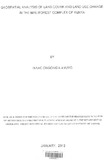| dc.description.abstract | This study employed the use of Remote Sensing and GIS to evaluate the Land Cover and Land Use Changes that had occurred between 1973 and 2010 in the Mau forest complex, Kenya. The study area is around 400,000 hectares and has the largest montane vegetation in East Africa. The significance of the Mau complex can be viewed in term of the enormous biodiversity of flora and fauna it has and the fact that, it forms upper water catchments to many major rivers. It also sustains many conservation areas and modifies the microclimate in the region. The Mau ecosystem has very high economic potential due to its very fertile soils
and high rainfall amounts.
The general objective of this study was to create a geospatial tool for land cover and land use change detection in the Mau forest complex that can be used in decision making. More specifically the study sought to: determine the present status of land cover and land use in the Mau; analyse changes that had occurred over time; determine human activities responsible for the changes; and to determine the environmental impacts associated with these changes.
Multispectral Landsat imageries for 1973, 1986, 2000 and 2010 were analysed usingENVI 4.8 software and applying Supervised Classification to classify the land cover and land use types. To achieve this, the first step involved the development of an appropriate classification scheme in which three classes namely - Forestland, Other Vegetation, and Non-vegetated land were used. After developing classification scheme, the study delineated training sites 'from each of the cover classes, defined the signatures for each land cover category and finally the software was instructed to use these signatures to classify the remaining pixels.
Post Classification Visual and Area Comparisons were done to get information on the trends, rates and magnitude of land cover and land use changes in the Mau forest complex over time. Overlay operations of the classified images were done under ArcGIS software to detect the changes that had occurred in each cover type over the study period. Overlays determined what actually changed to what, according to the land cover classes used. The process involved a pixel to pixel comparison of the study year images and the information got revealed both the desirable and undesirable changes over time and the classes that were relatively stable.
This information was kept in a geo-database and will serve as a vital tool in management decisions. To detect the variations in the greenness of the vegetation present in the pixel over time, Normalized Difference Vegetation Index (NDVI) was used with density slices ranging from 0.25 ).UIl to 1.00 urn (range of vegetation cover). Time series NDVI analysis was done to detect changes in plant health over time (healthy plants are greener). Field photography was used to capture various human activities taking place in the forest to help in the assigning of training sites and signatures. Integrated analysis in Mount Londiani forest (a case study) used thematic maps of land cover, population densities, slopes, land use, soils and graphs for rainfall distribution for comparative analysis among the variables.
The study established that, changes in Land Use and Land Cover had occurred in all the 22 blocks of Mau forest complex and resulted in the reduction of forest cover. This happened because the rates at which forest cover was converting to other land covers were higher than the rates at which the opposite was taking place. The study also found out that there was relationship between increase in population and decrease in forest cover and that, steep slopes were cleared of their forest as land use changed.
The study established that conversion of forest land to agricultural land was the main cause of deforestation in the Mau and resulted in the loss of biodiversity and partly led to reduction in rainfall and subsequent decrease in river discharge. This study recommends that conservation efforts in the Mau should be continued since they have yielded positive results. Secondly, the Government should enact laws, policies and regulations on land use and forest resource management which should incorporate all stakeholders. Lastly, the Government should develop a good and vibrant geo-database of the Mau forest complex to enhance decision making on conservation while further research on impacts of Land Cover and Land Use Change on livelihoods and on downstream projects, among others needed to be carried out. | en_US |

